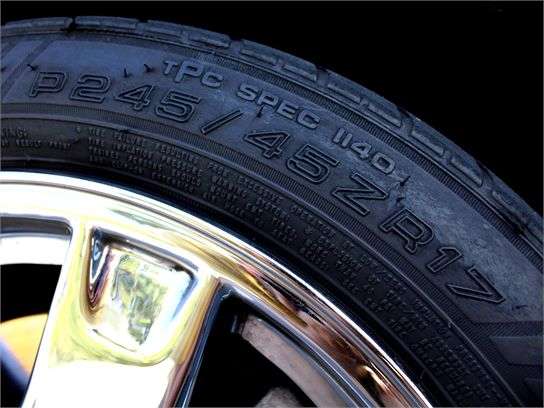Recent Articles
Popular Makes
Body Types
How to Read Tire Sizes
What Do The Numbers on Tires Mean?

Ever wonder what the numbers on a tire mean? The typical tire size is expressed something like this: P245/45R17 93H M+S. Those numbers and letters can seem like Greek, so let's figure out how to read tire sizes by defining them one at a time. P: The first letter stands for the tire's intended use. P is the most common and it means Passenger. LT stands for Light Truck. An LT tire has a sturdier construction than a P tire, and it can carry a greater load, which we will talk about later. 245: The width of the tire, from sidewall to sidewall, in millimeters. A 245 is 245 millimeters, or 24.5 centimeters, wide. The tread width is actually somewhat smaller than the tire's actual width. 45: Aspect Ratio. This is the sidewall's height from the inside diameter to the outside diameter. It is expressed as a percentage of the width. A 245/45 is 45 percent as tall as it is wide, making it approximately 110.25 millimeters tall. As aspect ratios decrease, the tire's firmness increases. Smaller aspect ratios, such as 35 or 40 are generally reserved for performance tires on sports cars. R: The tire's type of construction. R stands for Radial, and all new cars and light trucks today use radials. You may also see B in this spot for Bias Ply. Bias ply tires were used prior to the mid 1970s. 17: The tire's inner diameter, which matches the outer diameter of your car's wheels. 93: Load Rating. Load ratings range from 0 to 279 and each has a corresponding weight associated with it. A 93 load rating means that tire is certified to carry up to 1433 pounds at maximum inflation pressure. If a car weighs 4000 pounds, then each tire handles 1000 pounds with no passengers or cargo aboard. If you intend to tow a heavy boat or trailer, you should buy tires with a higher load rating. This will require some math to figure out the vehicle weight, the trailer weight, and the weight of a load you may carry inside the vehicle while towing. Add it all up, divide by four, and make sure your replacement tires have a corresponding load rating. H: Speed Rating. All passenger tires have a speed rating expressed as a letter. Those letters and the corresponding speeds the tires are capable of are included in this chart: S: 112 mph T: 118 mph U: 124 mph H: 130 mph V: 149 mph W: 168 mph Y: 186 mph Z: over 186 mph A Speed Rating is really an indication of a tire's ability to dissipate heat to avoid a blowout. Higher speeds mean greater heat buildup. Tires with higher speed ratings are constructed to handle heat better. In general, they also ride harder than tires with lower speed ratings. S-, T-, and U-rated tires are considered regular passenger-car tires. H- and V-ratings are reserved for touring tires, which are generally found on sport sedans. The Z rating is for performance tires found on sports cars. M+S: Mud and Snow. This is an all-season tire. A summer performance tire would have no designation here. No you will never need to ask the tire guy: "What do the number on tires mean?" Instead refer to this neat little guide on How to Read Tires!